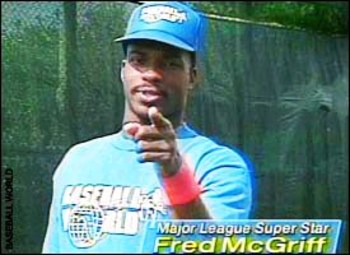Sometimes fate conspires to create natural rivalries between athletes. When two players begin their careers simultaneously (i.e., Eli Manning and Philip Rivers) and share similar roles it is obvious that their careers will be measured against one another. Perhaps the most famous example comes from the 1951 baseball season when two brilliant rookies – 20 year old Willie Mays and 19 year old Mickey Mantle – began their careers within weeks of one another. Over the next two decades they were inextricably linked as they smashed records, won awards, and on two occasions (1951, 1962) squared off in the World Series. Mantle enjoyed more success, winning an astounding seven World Series titles to Mays' one, while Mays racked up better numbers and was arguably the more complete player.
Obviously I was not alive in 1951, but most accounts of their rookie season indicate that the career path of both players was apparent the moment they reached the majors. That is, everyone knew as soon as they laid eyes on these guys that they would be superstars (although note that Mays' first great season didn't come until age 23, after a year of military service. Anyone else surprised to see that he missed a year for Korea? I certainly never knew that.) They both passed the eyeball test. Now certainly there is a hindsight bias in effect here; it is easy to look back on a superstar and say "Ah, I knew it all along!" Nonetheless, the near-immediate success of both players – Mantle led the league in OPS in his second season – suggests that it did not take a ton of prescience to recognize that these guys were both going to be incredible.
I feel like baseball fans are experiencing the same thing this season, a rare opportunity to see two young players who are quite obviously generational talents entering the league together. I'm referring to 19 year old Bryce Harper and 20 year old Mike Trout. Simply put, I've never seen two players enter the league at such a young age with such obviously elite talent (with the possible exception of Alex Rodriguez, who was similarly impressive at 20). Everyone knows about Harper, a #1 overall draft pick who has made headlines since he was 14, but if not for a baseball obsessed friend mentioning some of his mind-boggling minor league numbers I would not have been familiar with Trout before this season. Lots of young baseball players show the potential to be great, but not many of them are already great. Especially with Trout, it is so obvious to even the most casual fan that he has an astonishing level of talent that it would be more surprising if he wasn't a Hall of Fame caliber player 15-20 years from now.
Harper is playing a good CF – a position, mind you, that he never played in his life twelve months ago – and has more natural power than anyone this side of Josh Hamilton. His speed is above average but not elite, but he is likely to put up .300-35-100 seasons for the next dozen-plus years with the potential for 40-50 homer seasons. Trout, conversely, might top out power-wise at ~25 HR but he has ~.350 plate discipline and is probably the fastest player in the majors right now. There are some batting titles and 50+ SB seasons in his future, and probably a lot of them. More importantly, his talent looks completely effortless, whether he's leading the league in steals, winning the batting title by 20 points, or making over-the-wall catches he has no business making in center. He missed the first 20 games of the season languishing in the minors and yet he leads the league in three counting stats – runs, steals, and WAR – while putting up a ridiculous .356/.414/.606 at the moment. If he doesn't falter, he's likely to be just the third player to win RoY and MVP awards in the same season.
To make the comparisons more compelling, Harper and Trout have personality differences similar to Mays and Mantle. Mays was flashy, a big talker, and an anomaly in an era when black athletes were expected to Know Their Place. Harper is similarly brash – the words "arrogant" and "asshole" have been bandied about over the years – reflecting his healthy ego. Mantle, on the other hand, was seen as the quieter, all-American (read: white) boy with almost unbelievable five-tool talent, similar to Trout. Let's hope Trout doesn't turn out to be a surly closet alcoholic too.
There are only two previous times that I saw a player and immediately thought, "This guy is going to be in Cooperstown if he doesn't get hurt" – A-Rod and Frank Thomas, the latter of whom clearly lacked the all-around skill sets of guys like Trout and Harper. Even Ken Griffey Jr. didn't strike me as great immediately, and the numbers reflect that it took him several years to build up to superstar-level numbers. No one can predict the future, of course, and Harper/Trout might blow out a knee tomorrow and never be the same player again. It's also possible, albeit unlikely, that this is just a fluke and they will revert to being average players soon enough. Caveats aside, if I had to bet my life savings ($57) on one or both of these guys modeling for a bust in Cooperstown 25 years from now, I would do it with confidence.
